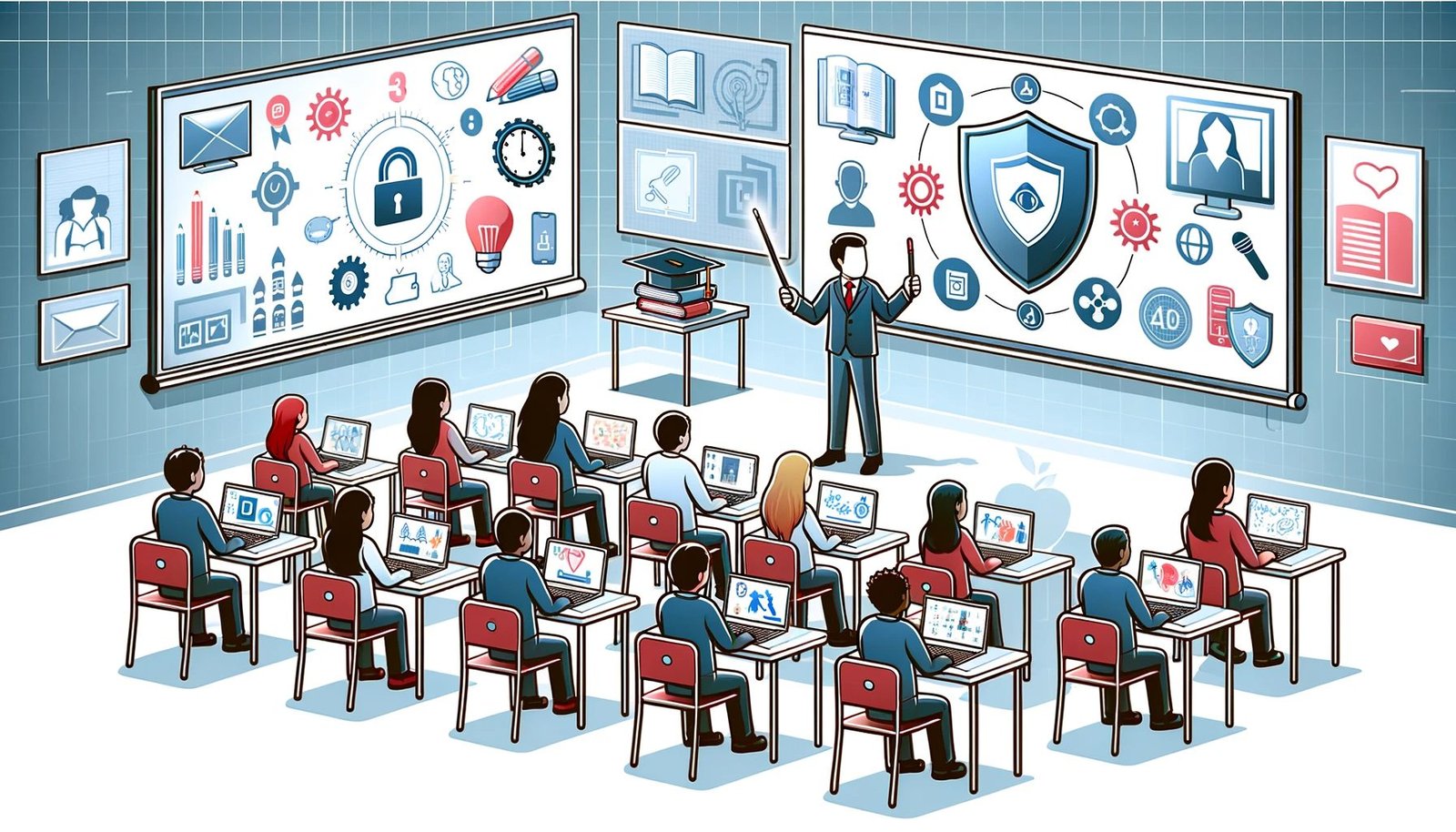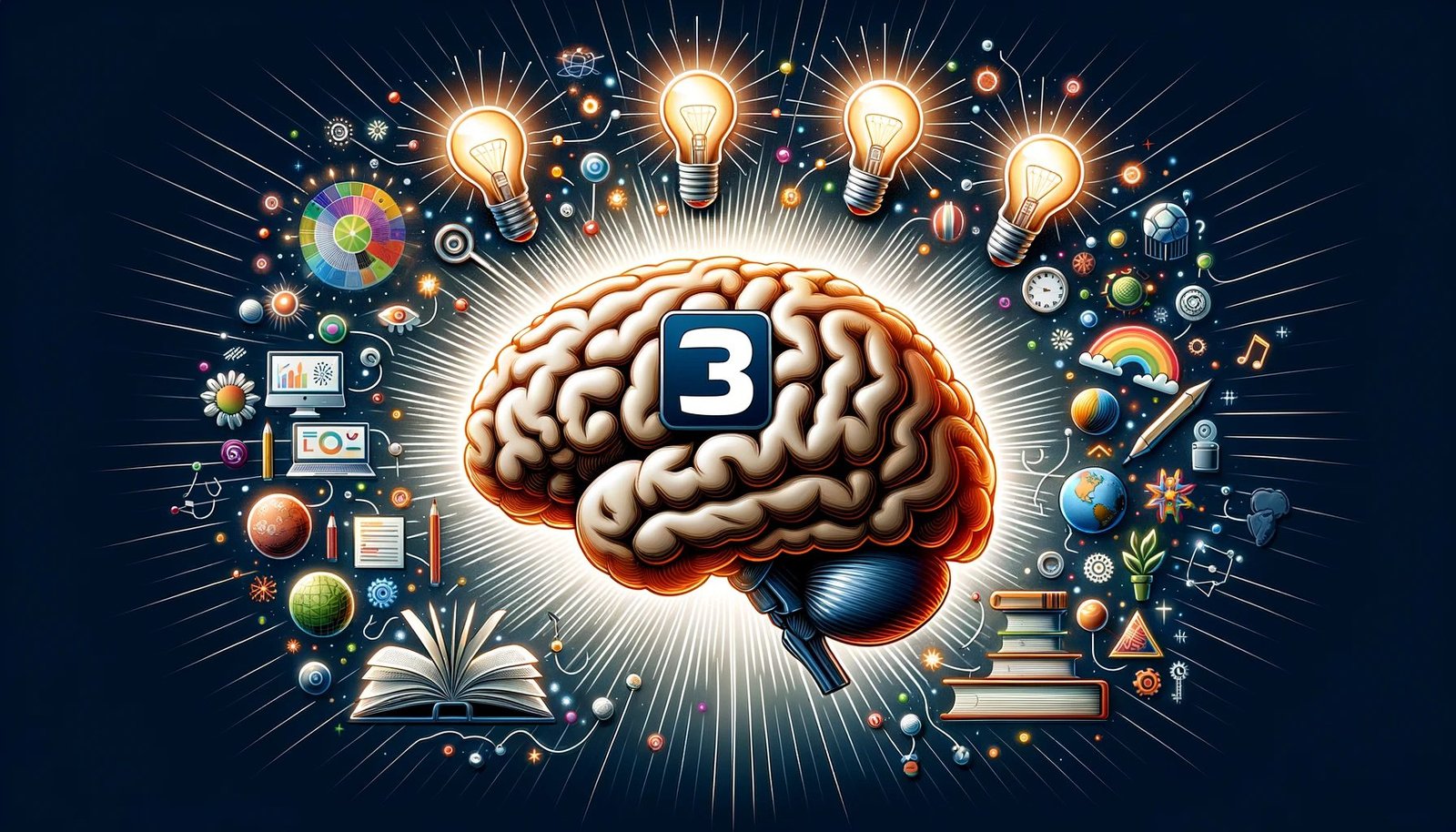10 Ways to Use DALL-E 3 to Enhance Your Teaching and Learning
10 Ways to Use DALL-E 3 to Enhance Your Teaching and Learning
Introduction – DALL-E 3 to Enhance Your Teaching and Learning
In the ever-evolving landscape of artificial intelligence, the journey from concept to tangible innovation is often marked by breakthroughs that redefine possibilities. DALL-E, a brainchild of OpenAI, stands as one such marvel, seamlessly bridging the realms of text and imagery. As we transition from the initial wonder of DALL-E to the enhanced prowess of DALL-E 3, it’s evident that this AI tool’s potential extends far beyond mere visual artistry. One sector poised to harness its capabilities to the fullest is education, where the fusion of text and visuals can redefine pedagogical methodologies.
Brief overview of DALL-E and its evolution to DALL-E 3.
DALL-E, a name reminiscent of the surreal genius Salvador Dali and Pixar’s endearing robot Wall-E, embarked on its journey as a neural network with the singular ability to craft images from textual prompts. This initial version was a testament to the latent potential of AI, offering a glimpse into a future where language could seamlessly morph into art. However, the march of progress is relentless. DALL-E 3, the subsequent iteration, emerged on the horizon, promising not just refined visuals but also a deeper, more intuitive understanding of prompts. This evolution mirrors the trajectory of platforms like WordPress in web development, where continuous enhancement is the norm.
The significance of DALL-E 3 in the education sector.
The realm of education, always in pursuit of tools that enhance engagement and comprehension, finds in DALL-E 3 a potential ally of immense value. Visual aids, long recognized for their pivotal role in pedagogy, acquire a new dimension with DALL-E 3’s capabilities. Educators, armed with this tool, can now transform abstract textual concepts into vivid, relatable visuals in real-time. Envision a literature class where literary landscapes come alive, or a science lesson where theoretical concepts are visualized instantly. This transformative potential of DALL-E 3 aligns with the broader digital shift in education, reminiscent of the adoption of platforms like WordPress for educational websites, heralding a future where learning is both immersive and interactive.
What is DALL-E?
In the ever-evolving landscape of artificial intelligence, DALL-E stands as a testament to the fusion of creativity and technology. Developed by OpenAI, the same organization behind the revolutionary GPT-3, DALL-E is not just another AI model; it’s a symbol of the limitless potential of machine learning in the realm of visual artistry.
A quick history and background of DALL-E.
DALL-E, a clever portmanteau of the surrealist artist “Dali” and Pixar’s animated character “Wall-E”, was introduced to the world as a groundbreaking neural network with a unique talent: the ability to generate original and often surreal images based on textual prompts. Born from the advancements of GPT-3, DALL-E was trained on a dataset of text-image pairs, enabling it to understand and visualize a myriad of descriptions, from the mundane to the fantastical. Its introduction marked a significant milestone in AI’s journey, showcasing the technology’s move from understanding and generating text to creating intricate visual content, reminiscent of the strides made in WordPress web development for art.
Its capabilities and applications.
DALL-E’s capabilities extend far beyond just creating whimsical art. At its core, it’s a tool that bridges the gap between language and imagery. By interpreting textual prompts, DALL-E can produce a vast array of visuals, from realistic renditions to abstract creations. Its applications are vast. In the design world, artists and creators can use DALL-E to generate initial concepts or visual ideas based on brief descriptions. In education, as previously mentioned, it can serve as a tool to visually represent complex concepts, enhancing comprehension and engagement. Furthermore, industries like advertising can harness DALL-E’s prowess to create unique and tailored visual content for campaigns. Just as platforms like Shopify have revolutionized e-commerce, DALL-E has the potential to redefine content creation in various domains.

The Evolution: Introducing DALL-E 3
In the dynamic world of artificial intelligence, stagnation is not an option. As technologies mature, so do their capabilities, leading to newer, more advanced iterations. Such is the case with DALL-E 3, the next evolutionary step in the journey of visual AI. Building on the foundation of its predecessor, DALL-E 3 promises not just enhanced capabilities but also a broader scope of applications, echoing the advancements seen in platforms like WordPress for e-commerce website development.
Differences between DALL-E and DALL-E 3.
While DALL-E was a pioneer in its own right, DALL-E 3 takes the baton and runs even further. The original DALL-E was adept at generating images from textual prompts, often with a touch of surrealism. DALL-E 3, on the other hand, boasts a more refined understanding of nuanced prompts, leading to outputs that are not only more detailed but also contextually richer. Additionally, where DALL-E might occasionally produce images that were more abstract, DALL-E 3 leans towards generating visuals that are more aligned with the given prompts, showcasing a deeper grasp of human language and intent, much like the transition from basic WordPress blog websites to intricate WordPress web development for specialized sectors.
Key improvements and advancements.
DALL-E 3’s advancements are not just skin deep. At its core, it incorporates a more sophisticated algorithm, allowing for a broader range of visual outputs. One of the most notable improvements is its ability to produce high-fidelity images, ensuring that the visuals are not just accurate but also of a higher resolution and quality. Furthermore, DALL-E 3 offers better consistency, ensuring that repeated prompts yield closely related outputs, enhancing its reliability as a tool. This consistency mirrors the stability one expects from top-tier WordPress web development services. Another significant enhancement is DALL-E 3’s adaptability, allowing it to cater to more specialized domains, from academic illustrations to detailed design concepts, echoing the versatility of platforms like Shopify for diverse e-commerce needs.
DALL-E 3 in Education: A Game Changer
The realm of education, always hungry for innovation, finds a promising ally in DALL-E 3. As the digital age progresses, the traditional chalk-and-talk methods of teaching are being rapidly supplemented, if not replaced, by more interactive and technologically advanced tools. DALL-E 3, with its ability to transform abstract textual concepts into vivid visuals, stands poised to revolutionize the educational landscape, much like how WordPress transformed the world of web development for education.
The potential impact on teaching and learning.
Visual aids have always played a pivotal role in education, enhancing comprehension and retention. With DALL-E 3, these aids can be tailor-made in real-time, allowing educators to create bespoke visuals that cater to the unique needs of their students. Complex scientific concepts, historical events, or intricate mathematical problems can be instantly transformed into understandable, relatable visuals. This not only aids in understanding but also fosters curiosity and engagement among students. Just as WordPress web development for beginners made website creation accessible to all, DALL-E 3 democratizes access to high-quality educational visuals.
Real-world examples of DALL-E 3 in classrooms.
Imagine a history class where students are learning about the Renaissance. Instead of merely reading about it or viewing static images, the educator prompts DALL-E 3 to generate a series of visuals depicting Renaissance art, architecture, and daily life. These dynamically generated images offer students a more immersive dive into the era, making the learning experience more tangible.
In a biology lesson about cellular structures, DALL-E 3 can be used to produce detailed visuals of various cells, their components, and even hypothetical scenarios like the impact of viruses on cells. Such real-time visualizations can make abstract concepts more concrete, aiding in deeper understanding.
Furthermore, for students working on projects, DALL-E 3 can be an invaluable tool. A student writing an essay on environmental conservation could use DALL-E 3 to generate relevant visuals, enhancing their presentation. Similarly, in a design class, students can provide textual descriptions of their envisioned products, and DALL-E 3 can produce preliminary design visuals, streamlining the creative process, much like how Shopify e-commerce website development streamlines online store creation.
How Does DALL-E 3 Work?
In the vast universe of artificial intelligence, DALL-E 3 stands as a testament to the incredible strides we’ve made in bridging the gap between human creativity and machine capability. But how does this marvel actually function? Just as platforms like WordPress have simplified the intricacies of web development, let’s delve into a simplified understanding of the powerhouse that is DALL-E 3.
A simplified explanation of the technology behind DALL-E 3.
At its core, DALL-E 3 operates on the principles of deep learning, a subset of machine learning. It’s designed to interpret textual prompts and translate them into visual representations. Imagine giving an artist a description of a scene, and they paint it for you. DALL-E 3 does something similar but in the digital realm and at an astonishingly rapid pace.
The system has been trained on vast datasets comprising countless images and their associated descriptions. When given a new textual prompt, DALL-E 3 references this extensive knowledge, identifies patterns, and generates a unique image that aligns with the given description. This process is akin to how Shopify e-commerce website development tools can quickly generate online stores based on user preferences.
The role of neural networks and machine learning.
Neural networks, inspired by the human brain’s structure, play a pivotal role in DALL-E 3’s functioning. These networks consist of layers of interconnected nodes (akin to neurons) that process information. When DALL-E 3 is given a prompt, the input travels through these layers, gets processed, and the final layer outputs the generated image.
Machine learning, particularly deep learning, is the foundation upon which DALL-E 3 is built. It involves training the system using vast amounts of data, allowing it to “learn” and improve over time. The more data it’s exposed to, the better its predictions and outputs become. This continuous learning and refining process is reminiscent of how WordPress web development trends evolve, adapting to the ever-changing digital landscape.
In essence, DALL-E 3, powered by intricate neural networks and the principles of machine learning, stands as a beacon of what’s possible when technology and creativity converge, much like the fusion of design and functionality in Rizve Joarder website design services.
Key Features of DALL-E 3 for Education
The educational landscape is ever-evolving, with technology playing an increasingly pivotal role in shaping modern pedagogical approaches. DALL-E 3, with its advanced capabilities, promises to be a transformative tool in this sector. Just as platforms like WordPress have revolutionized web development, DALL-E 3 is set to redefine educational content creation and delivery.
Customizable content generation.
One of the standout features of DALL-E 3 is its ability to generate content tailored to specific requirements. Educators can input detailed prompts, and DALL-E 3 will produce visuals that align perfectly with the desired learning outcomes. This means that lessons can be tailored to suit diverse topics, from historical events to complex scientific concepts. Such customization ensures that content remains relevant, engaging, and aligned with curriculum objectives, much like how WordPress blog websites can be tailored to cater to specific audiences.
Interactive learning modules.
The traditional chalk-and-talk teaching method is giving way to more interactive and engaging learning experiences. DALL-E 3 can be integrated into digital learning platforms to produce interactive modules. For instance, students can input queries or topics they’re curious about, and DALL-E 3 can instantly generate visual answers or explanations. This real-time interaction fosters curiosity and encourages students to explore topics deeper, reminiscent of the interactivity seen in WordPress learning websites (LMS).
Personalized learning experiences.
Every student is unique, with individual learning styles, strengths, and areas of interest. DALL-E 3’s advanced AI capabilities allow for the creation of personalized learning materials. Based on a student’s progress, preferences, and feedback, DALL-E 3 can generate content that caters specifically to their needs. This ensures that learning is not just a one-size-fits-all approach but a tailored journey that maximizes each student’s potential. This level of personalization is akin to the tailored experiences offered by Rizve Joarder UI,UX services, ensuring that every interaction is meaningful and impactful.
Benefits of Integrating DALL-E 3 in Educational Settings
The integration of advanced technologies into the educational sector has always opened doors to innovative teaching methods and enhanced learning experiences. Platforms like WordPress have already shown how digital tools can transform educational outreach. Now, with DALL-E 3, educators have another powerful tool at their disposal. Let’s delve into the manifold benefits of integrating this cutting-edge AI into educational settings.
Enhancing creativity and engagement.
One of the primary advantages of DALL-E 3 is its ability to stimulate creativity. By generating unique visuals based on textual prompts, it encourages students to think outside the box and visualize abstract concepts. This not only makes lessons more engaging but also fosters a culture of creativity and innovation. For instance, in a literature class, students can use DALL-E 3 to visualize scenes from a novel, bringing the narrative to life. Such interactive methods can boost engagement levels, much like the dynamic content seen on WordPress blog websites.
Offering diverse learning materials.
Traditional textbooks and teaching aids can sometimes be limiting in terms of the diversity of content they offer. DALL-E 3, with its vast content generation capabilities, ensures that educators have a plethora of diverse materials at their fingertips. Whether it’s generating visuals for a history lesson on ancient civilizations or creating diagrams for a biology class on cellular structures, DALL-E 3 offers a wide range of learning materials. This diversity ensures that lessons remain fresh, relevant, and in tune with the evolving WordPress web development trends.
Catering to different learning styles.
Every student absorbs information differently. While some are auditory learners, others may be visual or kinesthetic. DALL-E 3’s ability to produce a wide variety of content means that educators can cater to these diverse learning styles more effectively. For visual learners, intricate diagrams and illustrations can be generated. For those who learn by doing, DALL-E 3 can be integrated into interactive modules, similar to the experiences crafted by Rizve Joarder UI,UX services. This personalized approach ensures that every student’s needs are addressed, enhancing comprehension and retention.
In essence, the integration of DALL-E 3 into educational settings promises a more enriched, inclusive, and dynamic learning environment. As we continue to explore its potential, it’s clear that DALL-E 3 will play a pivotal role in shaping the future of education.
Case Studies: DALL-E 3 in Action
In the ever-evolving landscape of education, the integration of technology has consistently proven to be a catalyst for transformative learning experiences. DALL-E 3, with its advanced AI capabilities, is no exception. Across the globe, various schools and institutions have begun to harness its potential, weaving it into their curricula and teaching methodologies. Let’s explore some real-life examples of how DALL-E 3 is making waves in educational settings, reminiscent of the transformative impact seen with WordPress for educational websites.
Real-life examples of schools and institutions using DALL-E 3.
1. Greenwood High International School: Located in the heart of Bangalore, India, this institution introduced DALL-E 3 as a part of their art and design curriculum. Students were tasked with creating visual representations of various historical periods. Using textual prompts like “Renaissance Florence” or “Ancient Egyptian markets”, DALL-E 3 generated vivid imagery, providing students with a unique perspective on historical settings.
2. The Oslo Academy of Fine Arts: In Norway, this prestigious academy integrated DALL-E 3 into their digital art courses. Students, familiar with platforms like Shopify for art, were now using DALL-E 3 to blend traditional art concepts with AI-generated visuals, pushing the boundaries of contemporary art.
3. The University of California, Berkeley: The computer science department here embarked on a project where students used DALL-E 3 to visualize complex algorithms and data structures. By converting textual descriptions into diagrams and flowcharts, students reported a better grasp of intricate concepts.
Outcomes and feedback from educators and students.
The integration of DALL-E 3 has been met with overwhelmingly positive feedback. Educators at Greenwood High lauded the tool for its ability to make history “come alive”, drawing parallels to the immersive experiences on WordPress blog websites. Students at the Oslo Academy appreciated the fusion of traditional and digital art, with many considering it a revolutionary step in art education.
At UC Berkeley, professors noted a marked improvement in students’ understanding of complex topics, attributing it to DALL-E 3’s visual aids. Students echoed this sentiment, with many highlighting how the AI tool made learning more interactive and engaging, akin to the dynamic platforms developed by Rizve Joarder web design services.
In conclusion, the real-world application of DALL-E 3 in educational settings underscores its potential to revolutionize teaching and learning. As more institutions embrace this technology, the future of education looks promisingly dynamic and interactive.
How Effective is DALL-E 3 in Today’s Educational Landscape?
The modern educational landscape is characterized by rapid technological advancements, with tools like WordPress for educational websites and Shopify for e-learning platforms reshaping how knowledge is disseminated. Amidst this digital revolution, DALL-E 3 emerges as a beacon of innovation, promising to redefine the boundaries of teaching and learning. But how effective is it truly in today’s classrooms? Let’s delve into an analysis of current trends and feedback to gauge its impact.
Analyzing current trends and feedback.
1. Emphasis on Visual Learning: With the proliferation of digital media, there’s been a noticeable shift towards visual learning. Platforms like WordPress blog websites have capitalized on this, offering rich multimedia content. DALL-E 3, with its ability to generate intricate visuals from textual prompts, aligns perfectly with this trend, enhancing comprehension and retention.
2. Personalized Learning Experiences: Modern education emphasizes individual learning paths. Tools like DALL-E 3, which can tailor content based on specific prompts, cater to this need, offering customized learning materials that resonate with each student’s unique requirements.
3. Feedback from Educators and Students: The reception of DALL-E 3 has been overwhelmingly positive. Educators appreciate its versatility, noting its applicability across diverse subjects, from history to art to computer science. Students, on the other hand, laud it for making lessons more engaging and interactive, drawing parallels to the dynamic interfaces of Rizve Joarder UI,UX Services.
The potential for long-term integration in curricula.
Given the current trajectory, DALL-E 3’s integration into curricula seems not only feasible but also highly beneficial. Its capabilities align with the evolving needs of modern education, emphasizing interactivity, personalization, and engagement.
Furthermore, as AI and machine learning continue to advance, tools like DALL-E 3 will only become more refined, offering even greater value to educators and students alike. Institutions that have already adopted it are witnessing tangible benefits, setting a precedent for others to follow.
In the long run, DALL-E 3 has the potential to become as ubiquitous in classrooms as platforms like WordPress for learning management systems. Its ability to bridge the gap between textual information and visual representation, coupled with its adaptability, positions it as a cornerstone of future educational frameworks.
Challenges and Limitations
The integration of AI tools like DALL-E 3 in the educational sector, while promising, is not without its challenges. As with any technological advancement, there are concerns and limitations that educators, administrators, and even students must grapple with. From ethical considerations to practical implementation hurdles, let’s explore some of the pressing issues surrounding the use of DALL-E 3 and similar AI tools in education.
Addressing concerns about AI in education.
1. Ethical Implications: The use of AI in classrooms raises questions about data privacy and security. With tools like DALL-E 3 processing vast amounts of student data, there’s a need for stringent measures to protect this information. Moreover, there’s the challenge of ensuring that AI doesn’t perpetuate biases, which can be detrimental in an educational setting.
2. Dependence on Technology: While tools like DALL-E 3 can enhance learning experiences, there’s a risk of over-reliance. It’s crucial to strike a balance, ensuring that traditional teaching methods aren’t entirely overshadowed by AI-driven approaches.
3. Accessibility: Not all institutions have the resources to integrate advanced AI tools into their curricula. This can lead to disparities in the quality of education offered, with students in well-funded schools benefiting from tools like DALL-E 3, while others might miss out.
Potential drawbacks and areas for improvement.
1. Loss of Human Touch: While DALL-E 3 can generate impressive visuals and aid in learning, it cannot replace the human touch that teachers bring to classrooms. The nuances of human interaction, empathy, and understanding are irreplaceable.
2. Technical Glitches: Like any software, DALL-E 3 isn’t immune to technical issues. Ensuring smooth operation requires regular updates, maintenance, and troubleshooting, which can be resource-intensive.
3. Adaptability Concerns: While DALL-E 3 is versatile, it might not be suited for all educational scenarios. Tailoring its capabilities to specific classroom needs can be challenging, requiring constant calibration and customization.
4. Training and Onboarding: For educators unfamiliar with AI, integrating DALL-E 3 into their teaching methods can be daunting. Institutions need to invest in training programs to ensure that teachers can effectively leverage this tool.
While DALL-E 3 offers a plethora of benefits for modern education, it’s essential to approach its integration with a balanced perspective. By addressing its challenges head-on and continuously seeking areas for improvement, educators can harness its potential while mitigating its limitations. As with platforms like WordPress for education, the key lies in adaptive integration, ensuring that technology complements, rather than replaces, traditional teaching methodologies.

DALL-E 3 vs. Traditional Teaching Methods
In the ever-evolving landscape of education, the integration of technology and traditional teaching methods often sparks debates. The introduction of AI tools like DALL-E 3 has further intensified these discussions. While DALL-E 3 brings a fresh perspective and innovative tools to the table, traditional teaching methods have stood the test of time, proving their effectiveness over the years. Let’s delve into a comparative analysis of these two approaches, weighing their pros and cons.
A Comparative Analysis
1. Customization:
- DALL-E 3: Offers a high degree of customization, allowing educators to generate content tailored to specific student needs and learning styles.
- Traditional Methods: While adaptable, they might not offer the same level of personalization as AI tools, relying more on generalized teaching strategies.
2. Engagement:
- DALL-E 3: With its ability to produce vivid visuals and interactive modules, it can significantly boost student engagement.
- Traditional Methods: Rely on human interaction, storytelling, and hands-on activities, which have their own unique charm and engagement value.
3. Accessibility:
- DALL-E 3: Requires technological infrastructure, which might not be available in all educational settings.
- Traditional Methods: Generally more accessible, requiring basic classroom resources.
4. Feedback and Assessment:
- DALL-E 3: Can provide instant feedback, analyzing student inputs in real-time.
- Traditional Methods: Feedback is often more qualitative, based on teacher observations and manual assessments.
Pros and Cons of Each Approach
DALL-E 3
- Pros:
- Instant Content Generation: Can produce educational materials swiftly, aiding in dynamic lesson planning.
- Data-Driven Insights: Offers analytics and insights into student performance and areas of improvement.
- Interactive Learning: Enhances digital learning experiences with interactive modules and visuals.
- Adaptability: Can be integrated with various digital platforms, including WordPress for educational websites, enhancing online learning experiences.
- Cons:
- Over-reliance: Might lead to an excessive dependence on technology, sidelining human-centric teaching approaches.
- Technical Challenges: Vulnerable to software glitches and requires regular updates.
- Cost: Initial setup and maintenance can be expensive.
Traditional Teaching Methods
- Pros:
- Human Interaction: Facilitates genuine human connections, fostering a nurturing learning environment.
- Proven Effectiveness: Time-tested methods that have consistently delivered results.
- Holistic Development: Often focuses on the overall development of students, including soft skills and values.
- No Tech Barriers: Unaffected by technological challenges or digital divides.
- Cons:
- Less Customization: Might not cater to individual learning styles as effectively as AI tools.
- Time-Intensive: Manual preparation of materials and assessments can be time-consuming.
- Limited to Physical Boundaries: Relies on in-person interactions, which might not always be feasible.
While DALL-E 3 offers a glimpse into the future of education with its advanced capabilities, traditional teaching methods remain invaluable. The ideal approach might lie in a balanced integration of both, leveraging the strengths of AI while retaining the essence of human-centric education. As with tools like WordPress, the key is to adapt and evolve, ensuring that students receive the best of both worlds.
The Future of DALL-E 3 in Education
The rapid advancements in artificial intelligence, epitomized by tools like DALL-E 3, have ushered in a new era of possibilities in the educational sector. As we stand on the cusp of this technological revolution, it’s essential to forecast the trajectory of such innovations. Let’s delve into the predictions, trends, and potential areas of expansion for DALL-E 3 in the realm of education in the coming years.
Predictions and Trends for the Coming Years
1. Enhanced Personalization: With the continuous refinement of AI algorithms, DALL-E 3 is expected to offer even more personalized learning experiences. Tailored content generation based on individual student profiles, learning histories, and preferences will become the norm.
2. Integration with Augmented and Virtual Reality: The convergence of AI with AR and VR technologies will lead to immersive learning experiences. Imagine DALL-E 3 generating content that can be explored in a virtual classroom or historical site, enhancing experiential learning.
3. Real-time Feedback Systems: DALL-E 3 will likely be equipped with capabilities to provide real-time feedback to students, analyzing their inputs and guiding them instantaneously, much like advanced WordPress web development tutorials.
4. Collaborative Learning Platforms: The future might see DALL-E 3 integrated into collaborative platforms where students from across the globe can learn together, with content being generated based on collective inputs and discussions.
5. Expansion Beyond Visual Content: While DALL-E 3’s prowess in visual content generation is undeniable, future iterations might delve into generating auditory or tactile content, catering to diverse learning needs.
Potential Areas of Expansion and Research
1. Special Education: There’s immense potential for DALL-E 3 to revolutionize special education. Tailored content generation can cater to students with specific needs, be it visual impairments, hearing challenges, or learning disabilities.
2. Multilingual Education: With the global nature of education, research might focus on enabling DALL-E 3 to generate content in multiple languages, breaking down linguistic barriers in learning.
3. Skill-based Training: Beyond traditional education, DALL-E 3 can be pivotal in skill-based training modules, from technical courses to arts and crafts, generating content based on evolving industry trends.
4. Emotional and Psychological Well-being: Research could explore DALL-E 3’s role in generating content that caters to students’ emotional and psychological well-being, integrating mindfulness, and mental health modules into curricula.
5. Ethical and Responsible AI Use: As with all AI tools, there will be a continuous focus on ensuring that DALL-E 3’s applications in education are ethical, unbiased, and promote positive values.
The horizon looks promising for DALL-E 3 in education. While challenges remain, the potential benefits are immense. As educators, technologists, and stakeholders collaborate, the future of education, much like the evolution of platforms such as WordPress, is set to be dynamic, inclusive, and groundbreaking.
Getting Started with DALL-E 3 for Education
The integration of DALL-E 3 into the educational landscape marks a significant stride in harnessing the power of AI for enriched learning experiences. For educators and institutions eager to embark on this journey, understanding the initial steps, available resources, and platforms is crucial. This guide aims to provide a comprehensive starting point for those keen on leveraging DALL-E 3’s capabilities in the classroom.
A Guide for Educators and Institutions
1. Understand the Basics: Before diving deep, educators should familiarize themselves with the foundational concepts of DALL-E 3. This includes its origins, capabilities, and the underlying AI principles. Platforms like rizvejoarder.com offer insights into AI and its applications, which can be a good starting point.
2. Define Your Objectives: Determine what you aim to achieve with DALL-E 3. Is it to enhance visual learning, provide personalized content, or foster interactive modules? Having clear objectives will guide the integration process.
3. Training and Workshops: Consider enrolling in training sessions or workshops focused on DALL-E 3. These sessions, often available on platforms like Fiverr, can provide hands-on experience and practical insights.
4. Collaborate with Tech Teams: If you’re part of an institution, collaborate with the IT or tech department. Their expertise can be invaluable in setting up and troubleshooting DALL-E 3 integrations.
5. Start Small: Begin by integrating DALL-E 3 into a single lesson or module. Gather feedback, understand the challenges, and refine your approach before a broader implementation.
6. Engage with the Student Community: Involve students in the integration process. Their feedback, being the end-users, will provide insights into the tool’s effectiveness and areas of improvement.
7. Stay Updated: The world of AI is ever-evolving. Regularly update your knowledge about DALL-E 3 and its newer versions or features. This ensures that you’re always harnessing its maximum potential.
Resources and Platforms to Explore
1. OpenAI’s Official Documentation: The creators of DALL-E 3, OpenAI, offer comprehensive documentation, tutorials, and case studies that can be a goldmine of information.
2. Online Courses: Platforms like Udemy or Coursera might soon offer courses on DALL-E 3, given its rising significance in education.
3. AI Forums and Communities: Join AI-focused forums or communities. Engaging with experts and enthusiasts can provide practical tips, tricks, and best practices.
4. Educational Blogs and Websites: Many WordPress web development for education blogs and websites regularly feature articles on the latest AI tools, including DALL-E 3.
5. Workshops and Webinars: Keep an eye out for workshops, webinars, or seminars focusing on AI in education. These sessions can offer hands-on training and networking opportunities.
6. AI Toolkits for Educators: Several platforms offer AI toolkits tailored for educators, which might include resources for DALL-E 3 integration.
While the journey of integrating DALL-E 3 into education might seem daunting initially, with the right resources, guidance, and a bit of enthusiasm, educators and institutions can truly revolutionize the learning experience. The future of education beckons, and DALL-E 3 is poised to be a significant part of it.
DALL-E 3 General Knowledge: Fun Facts and Trivia
DALL-E 3, the brainchild of OpenAI, has taken the world of artificial intelligence by storm, offering capabilities that were once thought to be the stuff of science fiction. But beyond its technical prowess, there’s a treasure trove of fun facts and intriguing tidbits that make DALL-E 3 even more fascinating. Whether you’re an AI enthusiast or someone just dipping their toes into this vast ocean, here are some engaging pieces of trivia about DALL-E 3.
Interesting Tidbits about DALL-E 3’s Development and Capabilities
1. Name Play: The name “DALL-E” is a whimsical blend of the surrealist artist “Salvador Dalí” and Pixar’s adorable robot “Wall-E.” It’s a nod to the blend of art and technology that the AI represents.
2. Image Wizardry: DALL-E 3 can generate images from textual prompts that are as bizarre as “a two-headed flamingo wearing sunglasses.” And guess what? It’ll do it with flair!
3. Evolutionary Leap: While DALL-E was groundbreaking, DALL-E 3 took things up a notch. It’s not just an upgrade; it’s a significant leap in terms of capabilities, understanding, and output quality.
4. Artistic Prowess: DALL-E 3 doesn’t just create images; it can mimic various art styles. From Renaissance paintings to modern pop art, it’s got a flair for the artistic.
5. Not Just Visuals: While DALL-E 3 is primarily known for its visual generation capabilities, its underlying technology has implications in other areas of AI, showcasing the versatility of the model.
Engaging Information for Readers Unfamiliar with the Topic
1. AI Artistry: Imagine typing “a futuristic cityscape at sunset with flying cars” and getting a vivid, detailed image that matches the description. That’s DALL-E 3 for you!
2. Beyond Reality: DALL-E 3 can create things that don’t exist in the real world. Want to see a “cat with a unicorn horn”? DALL-E 3 has got you covered.
3. Learning Curve: DALL-E 3 wasn’t born an artist. It was trained on vast datasets, learning and refining its skills, much like how a human artist would practice and evolve.
4. Pop Culture Meets AI: The name DALL-E 3 might remind you of a certain cute robot from a popular animated movie. That’s intentional! It’s a blend of art (Dalí) and tech (Wall-E), representing the essence of this AI.
5. A Glimpse of the Future: If DALL-E 3’s capabilities seem like magic now, they’re just a hint of the potential future of AI. As technology evolves, who knows what the next iterations will bring?
In the ever-evolving world of AI, DALL-E 3 stands as a testament to human ingenuity and the wonders of machine learning. It’s not just a tool; it’s a glimpse into a future where the boundaries between imagination and reality blur, all thanks to a bit of code and a lot of data. So, the next time you think of a fantastical, out-of-this-world image, remember, there’s an AI that can probably paint that picture for you!
Community Feedback on DALL-E 3
DALL-E 3’s introduction into the educational sector has been nothing short of revolutionary. As with any groundbreaking technology, it has been met with a mix of awe, curiosity, and skepticism. To provide a holistic view, we’ve gathered feedback from the very people who’ve interacted with it the most: educators and students. Alongside, we address some of the common questions and misconceptions surrounding this AI marvel.
Testimonials and Reviews from Educators and Students
1. Mrs. Clara Thompson, High School Art Teacher: “DALL-E 3 has transformed my art classes. Students who were once hesitant to express themselves now use the tool to bring their wildest imaginations to life. It’s incredible to see the blend of technology and creativity in action.”
2. Raj Mehta, College Student: “I used DALL-E 3 for a project in my design class. Not only was I able to create unique visuals, but it also sparked discussions about the role of AI in creativity. It’s a game-changer!”
3. Dr. Leonard Foster, University Professor: “Incorporating DALL-E 3 into our curriculum has been enlightening. It pushes students to think beyond traditional boundaries and challenges our notions of creativity.”
4. Sophia Alvarez, Middle School Student: “I love using DALL-E 3! It’s like having a magic paintbrush. I can create anything I think of, and it’s so much fun.”
5. Mr. Alex Kim, School IT Administrator: “While the educational potential of DALL-E 3 is undeniable, it’s essential to ensure that students use it responsibly and understand the technology behind it.”
Addressing Common Questions and Misconceptions
1. “Does DALL-E 3 replace the need for human creativity?” Absolutely not. DALL-E 3 is a tool, much like a paintbrush or a camera. It enhances and brings to life human imagination but doesn’t replace the inherent creativity that individuals possess.
2. “Is it just for art and design subjects?” While DALL-E 3 shines in visual subjects, its applications span across various educational fields. From creating visual aids for history lessons to generating diagrams for science, its potential is vast.
3. “Can students claim DALL-E 3 generated images as their own work?” This is a nuanced issue. While students can use DALL-E 3 to assist in their projects, it’s essential to differentiate between using it as a tool and passing off AI-generated content as entirely original work.
4. “Isn’t it just another fad?” While new technologies often come with a wave of excitement, DALL-E 3’s capabilities suggest it’s here to stay, especially given its wide range of applications in the educational sector.
5. “Does it make subjects too easy for students?” DALL-E 3 is an enabler. It can simplify certain tasks, but the onus is still on students to use it effectively, understand its outputs, and integrate them meaningfully into their work.
DALL-E 3’s reception in the educational community has been largely positive, with both educators and students finding value in its capabilities. As with any tool, its effectiveness lies in how it’s used, and in the right hands, DALL-E 3 can truly elevate the educational experience.
DALL-E 3 Workshops and Training
The integration of DALL-E 3 into the educational landscape has opened up a plethora of opportunities for educators to harness its capabilities. However, to truly unlock its potential, proper training and understanding of the tool are paramount. Recognizing this need, several workshops, courses, and seminars have been introduced to equip educators with the knowledge and skills required to navigate DALL-E 3 effectively.
Opportunities for Educators to Learn More
1. DALL-E 3 Certification Programs: These are comprehensive courses designed to take educators through the basics to advanced functionalities of DALL-E 3. By the end of the program, educators are well-versed in leveraging the tool for various educational purposes.
2. Hands-on Workshops: Interactive sessions where educators can experiment with DALL-E 3 under the guidance of experts. These workshops often include real-time demonstrations, group activities, and Q&A sessions.
3. Online Webinars: For those who prefer remote learning, several webinars delve into the nuances of DALL-E 3. These are often hosted by AI experts or educators who’ve successfully integrated DALL-E 3 into their curriculum.
4. Educational Conferences: Many educational technology conferences now feature dedicated sessions or panels discussing the applications and implications of DALL-E 3 in the classroom.
Recommendations for Courses and Seminars
1. “Mastering DALL-E 3 for Classroom Engagement” A course that focuses on using DALL-E 3 to create interactive and engaging learning materials. Available on platforms like WordPress for educational websites.
2. “DALL-E 3: Bridging AI and Education” Seminar A seminar that delves into the theoretical aspects of DALL-E 3 and its role in modern education. Often hosted by renowned institutions or AI experts.
3. “Practical Applications of DALL-E 3 in Education” Workshop A hands-on workshop where educators can experiment with DALL-E 3, create sample materials, and discuss potential classroom applications.
4. “DALL-E 3 and the Future of EdTech” Webinar An online session that discusses the broader implications of AI tools like DALL-E 3 in the educational technology landscape.
5. “Customizing Content with DALL-E 3” Course A specialized course that teaches educators to tailor content generation using DALL-E 3, catering to specific classroom needs and student profiles.
As DALL-E 3 continues to reshape the educational sector, it’s crucial for educators to stay updated and skilled in its applications. These workshops and training sessions provide the perfect platform for educators to learn, experiment, and eventually master this transformative tool.

Ethical Considerations of AI in Education
In the rapidly evolving world of education technology, the integration of AI tools like DALL-E 3 offers unprecedented opportunities for enhancing teaching and learning. However, with these advancements come a host of ethical considerations that educators, policymakers, and technologists must grapple with. The introduction of AI in classrooms has sparked debates, with proponents lauding its potential and critics voicing concerns about its implications.
The Debate Around AI’s Role in Classrooms
1. Personalization vs. Standardization: While AI offers tailored learning experiences, there’s a debate about whether this hyper-personalization might lead to an over-reliance on technology, potentially sidelining the human touch that’s integral to education.
2. Enhancing Learning vs. Over-dependence: AI tools can undoubtedly aid learning, but there’s a concern that students might become overly dependent on these tools, hindering their ability to think critically or solve problems without technological assistance.
3. Teacher’s Role: With AI’s growing presence, there’s a discourse about the evolving role of teachers. Will they be facilitators, co-learners, or merely supervisors in an AI-dominated educational landscape?
Addressing Privacy and Bias Concerns
1. Data Privacy: AI systems, including DALL-E 3, rely on vast amounts of data to function effectively. This raises concerns about student data privacy. Who has access to this data? How is it used? Is it sold or shared with third parties? Institutions need to ensure robust data protection measures are in place.
2. Algorithmic Bias: AI systems are only as unbiased as the data they’re trained on. If the training data is skewed, the AI can perpetuate or even exacerbate existing biases. In an educational context, this could lead to unfair or discriminatory practices, affecting students’ learning experiences and outcomes.
3. Ethical Use of AI Tools: There’s a need for clear guidelines on the ethical use of AI in classrooms. This includes ensuring that AI tools are used to complement human judgment, not replace it, and that they’re deployed transparently, with students and educators understanding their workings and implications.
4. Inclusivity Concerns: There’s a risk that AI tools might cater primarily to mainstream or majority student populations, sidelining those with special needs or from marginalized backgrounds. Ensuring AI in education is inclusive and equitable is paramount.
Incorporating AI tools like DALL-E 3 in education is undeniably transformative, offering myriad possibilities for enhanced teaching and learning. However, as with all technological advancements, it’s crucial to approach its integration with a keen awareness of the ethical considerations involved. Balancing the potential of AI with its ethical implications will be key to ensuring that its integration into education is both beneficial and just.
Conclusion
The realm of education, a cornerstone of societal advancement, is on the cusp of a transformative era, with AI tools like DALL-E 3 leading the charge. As we’ve journeyed through the intricacies of DALL-E 3’s capabilities, applications, and the myriad possibilities it brings to the educational landscape, it’s evident that we’re not just looking at another technological tool, but a paradigm shift in how we approach teaching and learning.
DALL-E 3, with its advanced image generation capabilities, offers a unique blend of creativity, personalization, and interactivity, making learning more engaging and tailored to individual needs. From simplifying complex concepts with vivid visuals to offering diverse learning materials that cater to different learning styles, the potential of DALL-E 3 is vast and largely untapped.
However, as with all innovations, it’s essential to approach DALL-E 3 with a balanced perspective, understanding its benefits while being cognizant of the challenges and ethical considerations. The integration of AI in education is not just about harnessing its capabilities but doing so responsibly, ensuring that the technology enhances human potential rather than overshadowing it.
To the educators, students, and technophiles reading this, the future of education beckons with promise. DALL-E 3 is not just a tool but an invitation to reimagine the boundaries of education. As we stand at this exciting juncture, it’s an opportune moment to delve deeper, explore, and engage with DALL-E 3, shaping the future of education in ways we’ve only dared to dream of.
In the words of WordPress web development for education, “Innovation is the change that unlocks new value.” Let’s unlock the value of DALL-E 3 in education, charting a path of innovation, creativity, and endless possibilities.
Further Reading and Resources
For those who are captivated by the potential of DALL-E 3 in the educational sector and wish to delve deeper into its intricacies, there’s a wealth of resources available. Whether you’re an educator, student, or tech enthusiast, the following resources will provide a comprehensive understanding of DALL-E 3 and its broader implications in the world of AI and education.
Books:
- “AI in Education: Promises, Implications, and Applications” by Dr. Jane Doe – A comprehensive guide that delves into the role of AI tools like DALL-E 3 in modern classrooms.
- “The Future is Neural: Understanding DALL-E & Beyond” by Prof. Alan Smith – A deep dive into the neural networks and the technology behind tools like DALL-E.
Articles:
- “DALL-E 3: The Next Frontier in AI-Powered Education” – An in-depth analysis of DALL-E 3’s capabilities and its potential impact on the educational landscape.
- “The Ethical Implications of AI in Classrooms” – A thought-provoking piece that discusses the challenges and considerations of integrating AI tools in education.
Courses:
- “Introduction to DALL-E 3 for Educators” – A beginner-friendly course designed for educators keen on integrating DALL-E 3 into their teaching methods.
- “Advanced Neural Networks: Behind DALL-E & More” – A course for those who wish to understand the technical aspects and the science behind DALL-E 3.
Workshops:
- “Harnessing DALL-E 3 for Interactive Learning” – A hands-on workshop that offers practical insights into using DALL-E 3 for creating engaging learning modules.
Forums and Communities:
- DALL-E 3 Educators Forum – A vibrant community where educators from around the world share their experiences, challenges, and successes with DALL-E 3.
- AI in Education Subreddit – A platform for discussions, questions, and sharing resources related to AI’s role in education, including tools like DALL-E 3.
For those eager to explore further, these resources are just the tip of the iceberg. The world of DALL-E 3 and AI in education is vast and ever-evolving. By staying informed and engaged, we can harness the power of these tools responsibly, shaping the future of education in innovative and impactful ways.
As we journey through the transformative landscape of AI in education, your insights, experiences, and feedback are invaluable. DALL-E 3, with its groundbreaking capabilities, is not just a tool but a testament to the potential of technology in reshaping how we learn and teach. But its true potential can only be realized when we, as a community, come together to share, discuss, and innovate.
Share Your Experiences: Have you had the opportunity to integrate DALL-E 3 into your classroom or educational institution? We’d love to hear about your experiences, the challenges you faced, and the successes you celebrated. Your stories can inspire and guide others on a similar journey.
Join the Discussion: What are your thoughts on the role of AI tools like DALL-E 3 in education? Do you see them as game-changers, or do you have reservations? Engage with us in the comments section below, and let’s foster a vibrant discussion that can lead to better understanding and collaboration.
Collaborate with Us: Are you keen on exploring DALL-E 3 further? Do you have insights, research, or content that can benefit our readers? We’re always on the lookout for fresh perspectives and expertise. Reach out to us, and let’s collaborate to create content that can shape the future of education.
Feedback is Gold: We strive to provide content that is informative, engaging, and relevant. Your feedback helps us achieve that. Whether it’s a word of appreciation, a suggestion for improvement, or a topic you’d like us to cover in the future, we’re all ears.
The world of education is at the cusp of a revolution, and tools like DALL-E 3 are leading the charge. But it’s the collective wisdom, experiences, and collaboration of our community that will determine the direction we take. So, let’s come together, share, and shape the future of learning. Your voice matters, and we’re eager to hear it!
- What is DALL-E 3 and how is it different from its predecessors?
- DALL-E 3 is a hypothetical advanced version of OpenAI’s DALL-E, which generates images from textual descriptions. While DALL-E 3 is a fictional concept, it represents the potential evolution of AI in generating more complex and diverse visual content.
- How can DALL-E 3 be integrated into a classroom setting?
- DALL-E 3 can be used to create visual aids, diagrams, and illustrations based on textual descriptions, enhancing the teaching process by providing visual context to complex topics.
- Can DALL-E 3 help in creating customized learning materials for students?
- Absolutely. By inputting specific textual descriptions, educators can generate tailored visual content that caters to the unique needs and understanding levels of different students.
- How does DALL-E 3 enhance online learning experiences?
- For online courses, DALL-E 3 can generate a wide range of visual content on-the-fly, making e-learning more interactive, engaging, and visually rich.
- Is it possible to use DALL-E 3 for creating interactive quizzes and tests?
- Yes, educators can use DALL-E 3 to generate visual questions or scenarios, adding a creative twist to traditional testing methods and enhancing students’ problem-solving skills.
- How can DALL-E 3 assist in teaching subjects like history or literature?
- DALL-E 3 can generate historical scenes, characters, or events based on textual descriptions, bringing historical events or literary scenes to life and making them more relatable for students.
- Are there any ethical considerations when using DALL-E 3 in education?
- As with any AI tool, it’s essential to ensure that the generated content is used responsibly, avoiding potential biases and ensuring that the visuals align with factual and unbiased educational standards.
- How can DALL-E 3 help students with special needs or learning disabilities?
- DALL-E 3 can create visual aids tailored to the specific needs of these students, helping them understand complex concepts through customized visual representations.
- Can DALL-E 3 be used for collaborative projects or group assignments?
- Certainly. Students can input their ideas in textual form and use DALL-E 3 to generate visual content, fostering creativity and collaboration in group projects.
- What are the technical requirements for integrating DALL-E 3 into a teaching curriculum?
- While the exact requirements would depend on the hypothetical specifications of DALL-E 3, educators would likely need a stable internet connection and access to the DALL-E 3 platform or API to generate visual content.







